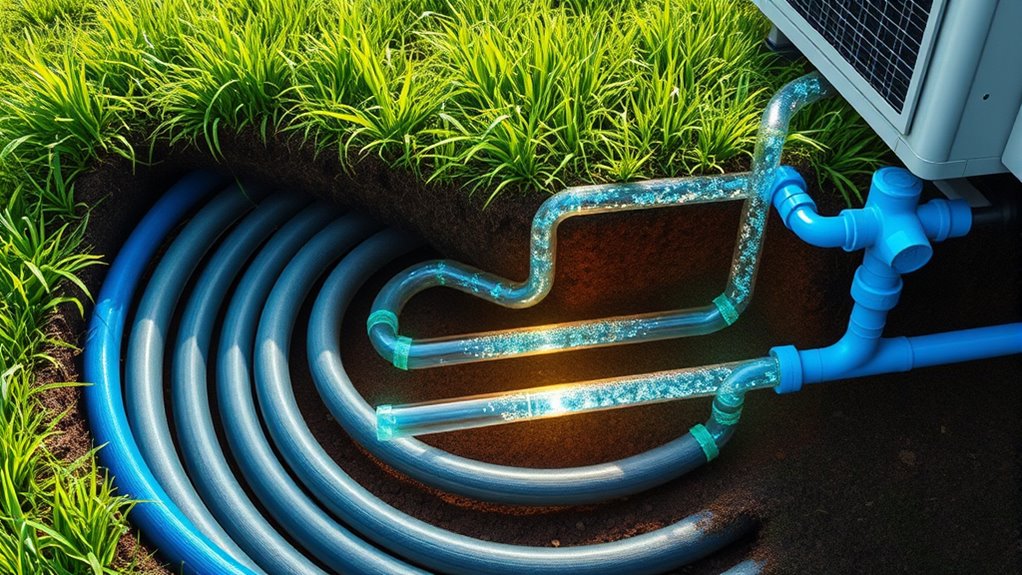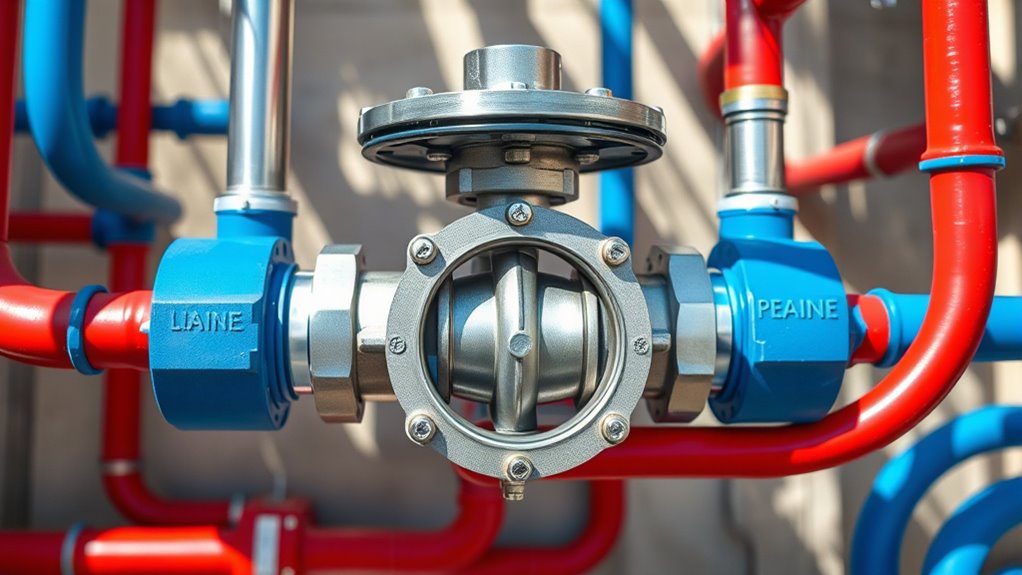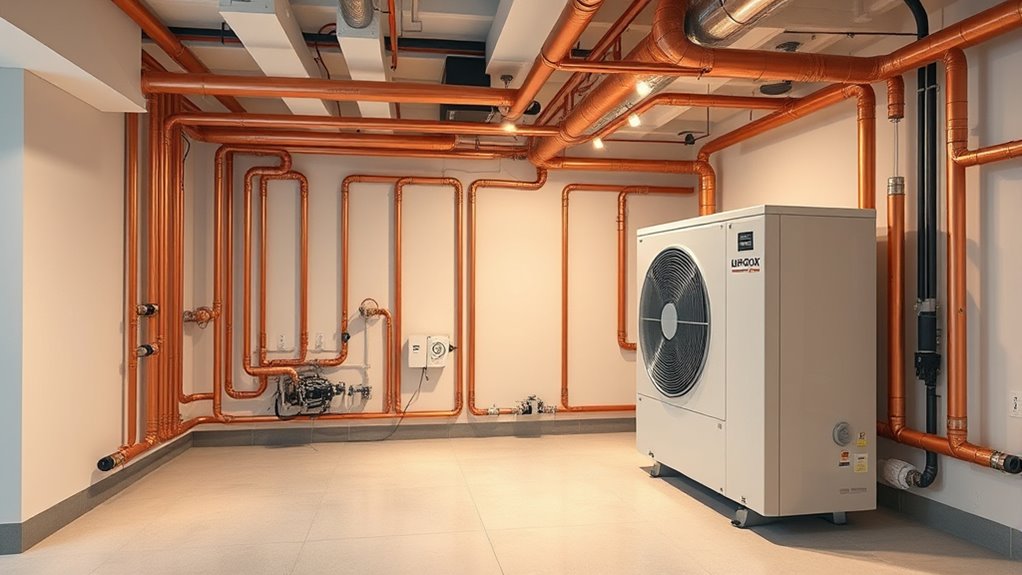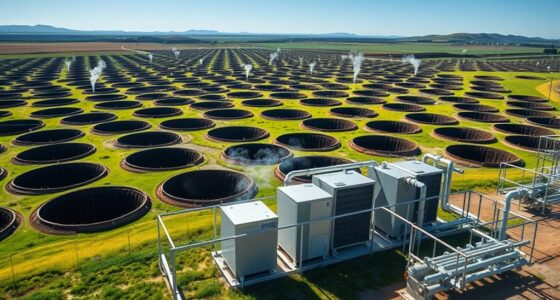A geothermal heat pump works by using underground loops filled with water-based solution to transfer heat efficiently. The outdoor unit contains components like a compressor, heat exchanger, and a reversing valve, which switch between heating and cooling modes. The system moves heat through refrigerant cycles, either absorbing heat from the ground during winter or releasing it in summer. To see how each part works together for your climate control, keep exploring further.
Key Takeaways
- Geothermal heat pumps transfer heat between the home and underground loops using refrigerant cycles.
- The ground loop system circulates water-based solutions through buried pipes to utilize stable underground temperatures.
- The compressor increases refrigerant pressure and temperature to release or absorb heat during heating or cooling.
- The reversing valve switches the system between heating and cooling modes by redirecting refrigerant flow.
- Conditioned air or water is distributed throughout the home via ducts or radiant systems for efficient climate control.
Components of a Geothermal Heat Pump System

A geothermal heat pump system relies on several key components that work together to transfer heat efficiently. Inside the indoor unit, the compressor raises the refrigerant’s pressure, enabling heat transfer. The heat exchanger facilitates heat exchange between the refrigerant and the indoor air, while the expansion valve regulates refrigerant flow. Controls within the system coordinate these operations to maintain ideal performance. The reversing valve switches the system between heating and cooling modes, redirecting refrigerant accordingly. The underground ground loop circulates a water-based solution, absorbing or releasing heat from the stable underground temperatures. All these components—compressor, heat exchanger, expansion valve, reversing valve, and controls—operate seamlessly to transfer heat between your home and the ground, ensuring energy-efficient climate control year-round.
The Ground Loop System and Its Role in Heat Transfer

The ground loop system forms the backbone of a geothermal heat pump, circulating a water-based solution through a network of high-density polyethylene pipes buried either horizontally or vertically. This system enables efficient heat transfer by leveraging the stable underground temperature of about 50-60°F year-round. When heating, the buried pipes transfer heat from the soil to the refrigerant, warming your space; during cooling, they absorb heat from the refrigerant and release it into the ground. Proper installation, considering soil composition and moisture levels, is key to maximizing heat exchange and ensuring system longevity. A well-designed ground loop:
- Enhances heat transfer efficiency
- Maintains consistent underground temperatures
- Supports reliable heat pump operation
- Uses durable, buried pipes
- Provides decades of minimal maintenance
How the Heat Pump Uses Refrigerant Cycles to Move Heat

Refrigerant cycles power how geothermal heat pumps transfer heat to and from your home by changing phases between liquid and gas. The cycle begins with the refrigerant passing through an expansion valve, reducing pressure and allowing it to evaporate in the evaporator for heat absorption. During heating mode, the compressor compresses the refrigerant, increasing its pressure and temperature, which then releases heat via the condenser to warm your home. In cooling mode, the reversing valve switches the refrigerant flow, enabling heat to transfer out of the home. The heat exchange occurs efficiently because of the phase change and the stable underground temperature. This refrigerant cycle’s effectiveness relies on precise control of compression, expansion, and heat transfer, maximizing energy efficiency and providing reliable heating and cooling. Proper refrigerant management and the use of environmentally friendly refrigerants are essential for reducing the environmental impact of geothermal heat pump systems. Understanding the importance of refrigerant properties can further enhance system efficiency and sustainability. Additionally, advancements in refrigerant technology continue to improve the overall performance and eco-friendliness of these systems.
The Reversing Valve and Its Function in Heating and Cooling Modes

The reversing valve is a key component in a geothermal heat pump that enables it to switch seamlessly between heating and cooling modes. It is a four-way valve that redirects refrigerant flow, allowing the system to adapt to your climate control needs. During heating, the reversing valve directs refrigerant to absorb heat from the ground and transfer it indoors. In cooling mode, it reverses flow, extracting heat from indoors and releasing it into the ground loop. The valve contains a solenoid that, when energized, shifts its internal spool to toggle refrigerant pathways. Proper operation is vital for system efficiency, ensuring smooth mode switching. Malfunctions or failure can cause improper refrigerant flow, system malfunction, or reduced performance. Both the reversing valve and the refrigerant flow are crucial for optimal system operation. Regular maintenance and understanding of system components can help prevent issues and prolong system lifespan. Additionally, ensuring the system controls are correctly calibrated can optimize switching performance and energy efficiency. Incorporating routine inspections can further help identify potential issues early and maintain peak system performance.
The Process of Distributing Conditioned Air or Water Throughout the Home

Once the geothermal heat pump has conditioned the air or water, it’s designed to deliver that comfort efficiently throughout your home. The distribution system transports heated or cooled air via ducts or water through radiant floors and panels. Ductwork in forced-air systems evenly distributes conditioned air through vents in each room, while radiant floors circulate hot water through embedded tubes for consistent warmth. Control valves and thermostats regulate temperature and maintain comfort across different zones. A well-designed distribution network minimizes energy loss, ensuring that the conditioned air or water retains its temperature as it reaches every part of your home. Vertical storage solutions and other space-saving methods can help optimize the placement of equipment and ductwork, further enhancing efficiency. This efficient process guarantees your space stays comfortable, whether heating or cooling, with minimal waste.
Frequently Asked Questions
How Do Geothermal Heat Pumps Work Step by Step?
You start by installing underground loops filled with a water-based solution. In winter, your pump extracts heat from the stable ground temperature to warm your home. During summer, it reverses, pulling heat from your indoor air into the ground to cool your space. The system uses a refrigerant cycle with a compressor, transferring heat efficiently by leveraging Earth’s consistent underground temperature.
What Is the Downside of Geothermal Heating?
You might find the upfront costs of geothermal heating a bit intimidating, as they can range from $10,000 to $40,000. Installation can be complex, especially with challenging soil conditions or limited space, leading to delays and extra expenses. Retrofitting older homes often requires extensive work, increasing costs and disruption. While long-term savings are attractive, these initial investments can be a significant hurdle for many homeowners.
What Is the Temperature at 10 Feet Underground?
You’re wondering about the temperature at 10 feet underground. Typically, it stays between 50°F and 60°F (10°C to 16°C) year-round, remaining steady regardless of seasonal changes. This consistent temperature results from soil’s natural insulation, though it can vary slightly based on your location, soil type, and climate. Near the equator, it’s a bit warmer, while colder regions tend to be closer to freezing.
How Much Does It Cost to Put Geothermal in a 2000 Sq Ft House?
You’ll typically spend between $20,000 and $40,000 to install a geothermal system in your 2,000 sq ft home. Horizontal loops are cheaper, around $15,000 to $30,000, while vertical systems cost more, from $25,000 to $45,000. Keep in mind, additional expenses like permits and ductwork may add to this. However, incentives, tax credits, and rebates can help offset these costs, making it a worthwhile long-term investment.
Conclusion
So, after all this, you might think geothermal heat pumps are just complicated gadgets. But in reality, they’re quietly working beneath your feet, saving you energy and money—no magic involved. Ironically, what seems like high-tech wizardry is just smart science and simple physics doing their thing. So, next time you flip the switch, remember: it’s your ground’s secret gift, working tirelessly while you enjoy cozy comfort without a second thought.









